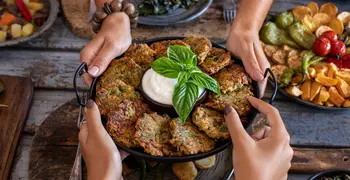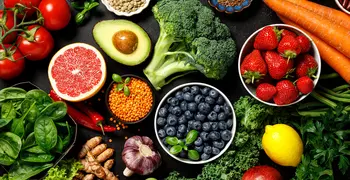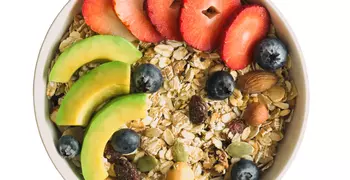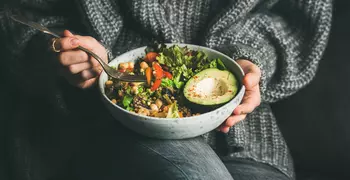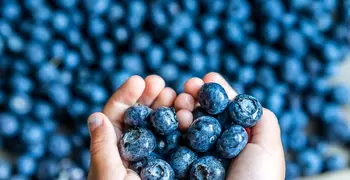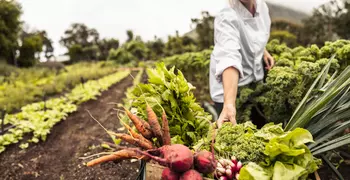Prepare Food for Health and Safety

Healthy eating also involves preparing food to preserve nutrients and prevent disease, as well as paying attention to food production issues.
Healthy cooking
When preparing food, aim to preserve the nutrient value of the food and utilize healthy fats, reasonable portions, and whole foods. Here are a few tips:
- Use healthy cooking methods such as steaming, broiling, grilling and roasting. Frying requires adding fat to achieve the desired results and deep-fried foods add considerable fat to the American diet.
- Cook foods in as little water and for as short a period of time as possible to preserve all water soluble vitamins (Bs and C).
- Use a variety of herbs and spices for additional flavor rather than relying on salt alone.
- Avoid packaged or processed foods, which are likely to contain added salt, sugar and fats. Recognize that consuming these foods increases your intake of salt, sugar, and fats considerably (often without knowing specifically what or how much). As we eat more and more processed foods, we eat less of the phytochemicals and nutrients our bodies need.
Note that those at high-risk for foodborne illness should follow additional guidelines. This includes:
- Pregnant women
- Young children
- Older adults
- People with weakened immune systems or certain chronic conditions
Safe food preparation
Foodborne illnesses don't just come from restaurants. In fact, they usually come from bad food preparation, serving, and storage at home. Follow the guidelines below to keep your food as safe as possible:
 Wash hands and surfaces often using hot, soapy water. Wash your hands before and after you handle food or utensils, especially raw meat, poultry, fish, or eggs.
Wash hands and surfaces often using hot, soapy water. Wash your hands before and after you handle food or utensils, especially raw meat, poultry, fish, or eggs.- Wash all fruits and vegetables before eating.
- Separate raw, cooked, and ready-to-eat foods. Keep raw meat, poultry, fish, or eggs away from other foods to prevent cross-contamination. If possible, use separate cutting boards for these foods. If not, be sure to wash cutting boards carefully with soap between uses.
- Cook foods to a safe temperature using a food thermometer. Uncooked or undercooked animal products can be unsafe.
- Keep hot foods hot (above 140 degrees) and cold foods cold (below 40 degrees) to prevent bacteria growth. Refrigerate foods within two hours of purchase or preparation (one hour if the temperature is higher than 90 degrees).
- When in doubt, throw it out. If you are not sure that food has been prepared, served, or stored properly, throw it out. If food has been left out for more than two hours, throw it out. Eat cooked leftovers within four days.
Know how your foods were produced
Food production is another important component of nutrition and health. This is a complex issue with lots of factors, some of which you cannot control. For example, food grown in healthy soil will supply necessary trace minerals to the food, but when soils are pressured for large-scale production, essential trace minerals can be lost.
However, you can make many choices:
- Buy organic foods for all or some of your diet (check the ‘dirty dozen’ list for those that are most heavily sprayed).
- Buy meat from producers who don't use antibiotics.
- Reduce your intake of fish high in mercury. The EPA recommends eating up to 12 ounces of fish that are lower in mercury weekly, including shrimp, canned light tuna, salmon, pollock, and catfish and avoiding shark, swordfish, king mackerel, and tilefish.
When to buy organic (and when it's safe not to)
The dirty dozen
Some produce items have heavier pesticide residue than others. Be sure to only buy organically grown versions of the following fruits and vegetables:
- Apples
- Celery
- Cherry tomatoes
- Cucumbers
- Grapes
- Hot peppers
- Imported nectarines
- Peaches
- Potatoes
- Strawberries
- Spinach
- Sweet bell peppers
When possible, also try to buy these organic:
- Kale
- Collard greens
- Summer squash
The clean 15
These foods have low pesticide residue, making it safe to purchase non-organic versions of them:
- Onions
- Sweet corn
- Pineapples
- Avocado
- Cabbage
- Sweet peas
- Asparagus
- Mangoes
- Eggplant
- Kiwi
- Cantaloupe (domestic)
- Sweet potatoes
- Grapefruit
- Papayas
- Mushrooms













